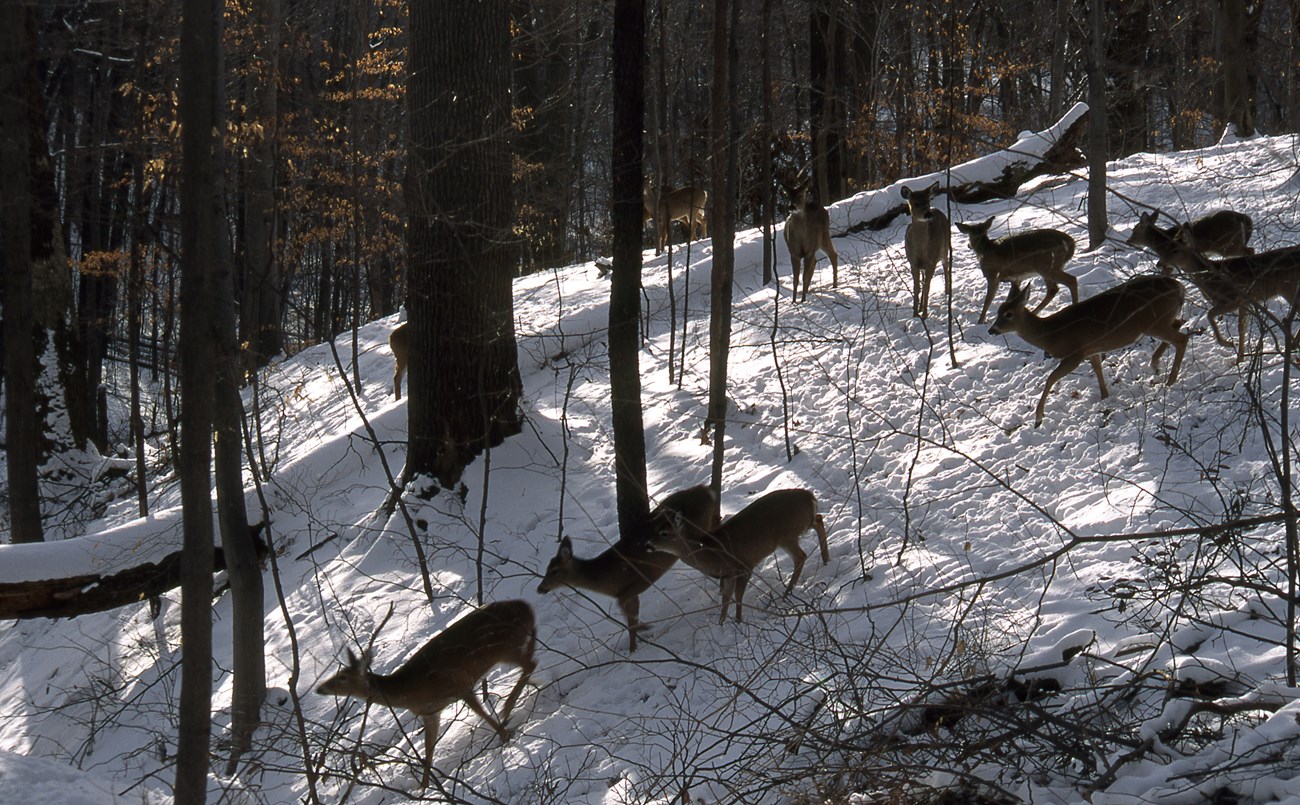
NPS / TOM JONES Deer are a common sight in Cuyahoga Valley National Park (CVNP). Have you ever wondered, however, about the impact of so many deer? Two familiar concerns are automobile accidents and damage to landscaping. Less familiar are the impacts of deer on the natural environment. Since the mission of the National Park Service (NPS) is to protect the natural resources of parks, this latter concern has led to the decision to develop and implement a CVNP deer management plan. What does that mean and how do we decide when there are too many deer? Use this bulletin as a guide for understanding the status of white-tailed deer in CVNP and the research that is helping us understand deer impacts and make decisions. Deer Population FactorsThe high population level of white-tailed deer is tied to its natural history. The white-tailed deer is a prey animal. Like other prey animals, it reproduces at a high rate. Most does, at 1 1/2 years of age, have their first single fawn. In each successive year of their average five year life span, does typically will have twins or triplets. These high birth rates outweigh population losses from predation. Coyotes are the only predators in CVNP that prey on deer, primarily scavenging on dead deer or taking newborn fawns. The legislation that established CVNP prohibits public hunting on park property. Trends in PopulationBy the early 1900s, deer nearly disappeared from Ohio due to the loss of forests and unrestricted hunting. Reestablishment of the deer population began in the 1930s as a result of several factors: hunting controls; a restocking effort in southern Ohio; immigration of deer from Michigan and Pennsylvania; and improved habitat created by a mix of agriculture, old fields, and forest fragments. Since the 1960s, Ohio’s deer population has grown dramatically. From an estimated 17,000 deer in 1965, to 750,000 deer at its peak in the early 2000s. Likewise, the deer population in CVNP has grown to unprecedented levels. Best estimates of deer densities in eastern forests prior to European settlement are 8-11 deer per square mile. Research has shown that deer begin to adversely affect their natural surroundings at 10 to 20 deer per square mile. While deer densities in CVNP have decreased in recent years to between 30 and 60 deer per square mile, these densities remain above the levels that are considered desirable for forest regeneration. Observing Deer ImpactsA healthy forest in our region has trees ranging from the smallest seedlings to towering giants. The forest floor is covered with many different kinds of wildflowers, including large expanses of white trillium. The different layers of the forest support a great variety of birds, insects, and other wildlife. When walking in our forests today, observe how many woodlands differ from a well-balanced ecosystem. You see few young tree seedlings, and the larger trees have been browsed below three feet, leaving the lower forest layers nearly bare. You will likely find few, if any, trillium and other wildflowers. In their place is an abundance of garlic mustard and other invasive, exotic plants. This situation reflects the impact of large deer populations on the forest as understood by scientific studies. Scientists consider trillium an indicator species for white-tailed deer impacts, since it is a preferred food that fails to flower when browsed by deer. Plant monitoring at locations throughout CVNP has revealed decreases in flowering trillium, less diversity of ground cover and shrubs, and fewer tree seedlings. This scenario is not unique to CVNP or to northeastern Ohio. Adverse ecological impacts of high numbers of deer (and other hoofed animals) have been documented in hundreds of scientific studies throughout the United States. Management PlanCVNP's has secured permits by the Ohio Division of Wildlife to use sharpshooting on park property to reduce deer populations. NPS is contracting with the Wildlife Services branch of the U.S. Department of Agriculture to provide experienced and trained staff to implement the deer program. Most culling activities will be away from established trails, in open fields and meadows using truck mounted platforms or tree stands to ensure the humane and safe removal of deer. NPS is partnering with Cleveland and Summit Metro Parks for meat processing and donation to area food banks. Activities will take place between dusk and midnight, on weekdays (Monday through Thursday). At times, specific areas will be temporarily closed to ensure public safety. Metroparks staff will patrol the park during removal actions to ensure compliance with park closures and public safety measures, and accompany NPS teams in the field. |
Last updated: June 21, 2020
